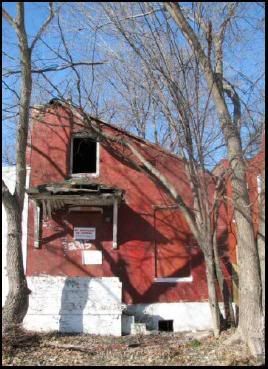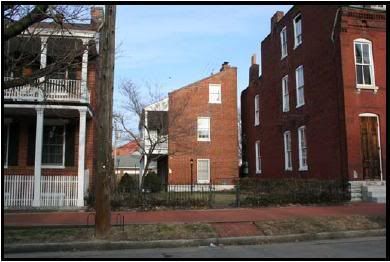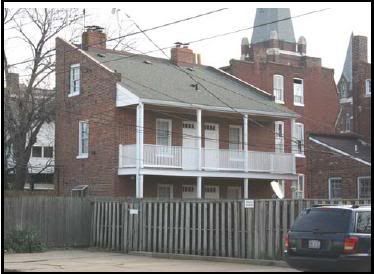
Reviewing the St. Louis Cultural Resources Office's reports, demolition reviews, etc. might not sound like an exciting way to spend a Saturday (or any day, for that matter), but preservationists and architectural enthusiasts will understand. I like to see what owners feel can't--or shouldn't--be rehabilitated. I like to read the testimony of impassioned neighborhood activists who believe that simply erasing their significantly vacant built environments eradicates the problems of the neighborhood all at once. I like to read the counter-stories to these testimonies; the ardent preservation advocates who call for patience and, with it, a sensitivity to the built environment, a recognition of its potential benefits for the community in the long run. These may sound like mundane arguments taking place in stuffy government buildings away from sight for most of us, but, to preservationists, these are the soap operas that define our profession, or hobby, or side-job, or all of the above.
Every once in a while, though, you learn something from giving the neighborhoods around you a closer look. I had never noticed that the building pictured in this post is in fact a style only found in St. Louis: the free-standing flounder building. You may have seen these as back or side units attached to 19th century rowhouses and such (usually with a more steeply pitched half-roof than this one has), but have you ever seen one with street frontage and its own spotlight?
Every once in a while, though, you learn something from giving the neighborhoods around you a closer look. I had never noticed that the building pictured in this post is in fact a style only found in St. Louis: the free-standing flounder building. You may have seen these as back or side units attached to 19th century rowhouses and such (usually with a more steeply pitched half-roof than this one has), but have you ever seen one with street frontage and its own spotlight?
According to the report, the flounder house is threatened with demolition. Located in the eastern portion of the Tower Grove East neighborhood (nearer to Gravois), this house at 2915 Minnesota is said to be one of the only remaining homes of its type in the city. Due to its condition and neighbors' complaints, however, 6th Ward Alderperson Kacie Starr Triplett has requested that it be torn down.
On a side note, who that doesn't live in the ward realized that this was the 6th Ward? I thought that that ward was more Lafayette Square/Gate District/Downtown West-centric, but apparently there's some gerrymandering of some sorts going on.
Anyhow, to shorten the story, Kate Shea of Cultural Resources recommended the building be saved, citing examples of similarly shaped and sized (at a decidedly tiny square footage of 527) that were spared the wrecking ball treatment. Those pictured below are in Soulard and Benton Park (not sure which, to be honest).


I found this report interesting for two reasons. I loved that this is a unique St. Louis style (who that is not claustrophobic can resist the unbearable cuteness of the rehabbed Soulardian/Bentonian flounders?). And I was also amazed that, as a city, despite our preservation-by-neglect (translation: couldn't afford demolition) approach to the field, people are still, in 2008, willing to see buildings simply removed from the landscape. They would rather have a vacant lot than a potentially tax-paying, living, breathing fellow citizen as a neighbor--architectural admiration issues notwithstanding.
That's the wrong direction for St. Louis. I hope to do an extensive post on the Ville Neighborhood in the future. That neighborhood, the cradle of St. Louis's black culture and our own little "Harlem" of the Midwest, has seen rampant decay and subsequent demolitions. The Aldermen have come and gone, and the buildings have done so more quickly. Horrific, anti-urban infill has popped up and has compromised the context of this all-too-important and historic neighborhood. Enough remains to rebuild the Ville and restore it to its proper prominence, but that is quickly changing at the insistence of its own leadership (as well as the complicity of the other aldermen and the mayor).
Destroying an empty building does not solve the problems of urban neighborhoods; it merely further empties the neighborhood and chips away at extant investment opportunities. This makes little long-term economic, ecological, civic, or cultural sense. So why do we do it?
It is more likely that the Tower Grove East flounder house will be saved. It is located in a "viable" neighborhood. But if even it is threatened, this rare and unique style of building, it does not bode well for our more isolated and "written-off" areas such as the Ville, where poor residents who have stuck with the neighborhood are fed the message that if only they can quash these problem properties and see them reduced to rubble, somehow peace will return to their own plots of land.
It's disingenuous, short-sighted, and wrong. St. Louis, to be cliche, deserves better. As do Tower Grove East on the South Side and the Ville on the North.



2 comments:
Well-written!
Thanks. :D
Post a Comment